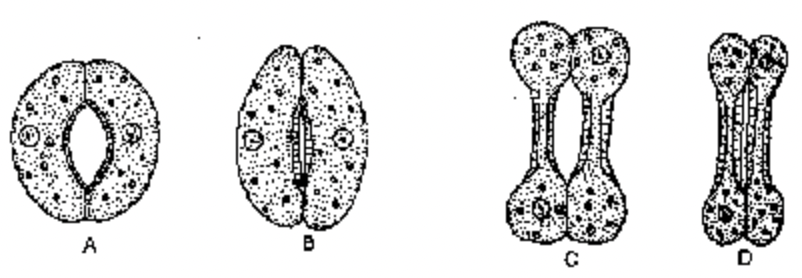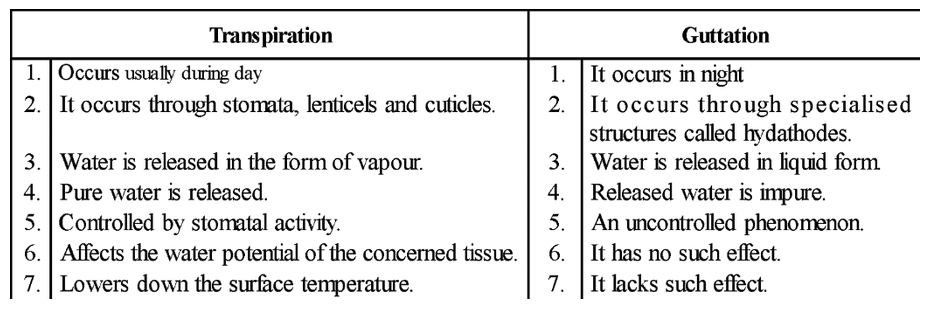What is Stomata
Transport In Plants of Class 11
About Stomata
The loss of water in the form of vapours from the aerial parts of the plant is called transpiration. Stomata are microscopic regulated pore complexes which occur in the epidermis of leaves and other soft plant organs. They are specialised for gaseous exchange. Stomata occupy only 1-2% of surface but their diffusive capacity is quite high, almost equal to the whole surface area of the leaf.
It has two small-sized differentially thickened green epidermal cells called guard cells. The common walls are not fused but are free from each other for most of length. Being small sized, guard cells can undergo rapid turgor changes. On swelling they bend outwardly to create a pore between them. On the loss of turgidity, the guard cells contract to bring their free walls in contact with each other. This closes the pore. Guard cells may further be surrounded by two or more specialised cells called subsidiary cells.
Guard cells are connected with nearby epidermal cells by plasmodesmata. They contain a few small chloroplasts and small vacuoles. In shape, guard cells are of two types, reniform (kidney-shaped) and dumbell-shaped. Dumbbell-shaped guard cells occur in grasses. Reniform or guard cells occur in all other plants Their outer walls are thick and their inner walls are thin.

Fig. Stomata
Types Of Stomata Depending Upon Periodicity Of Stomata
On the basis of period of their opening and closing, stomata are of the following types. (i) Cereal (Barley) Type. The stomata open for a few hours during the day, e.g., Wheat, Barley, Maize. (ii) Alfalfa (Leucerne) Type. Stomata remains open throughout the day and close at night. Under conditions of reduced availability of water, the stomata open for shorter duration during evening and night. Succulents keep their stomata open only during night, e.g., Alfalfa, Mustard, Radish, Opuntia. (iii) Potato Type. The stomata remain open both during day and night. In case of water deficiency, stomata close for a few hours at specific time of the day, e.g., Potato, Cucurbita. Tulip. (iv) Equisetum Type. The stomata seldom close, e.g., Sagittaria.
Types Of Stomata Depending Upon
Distribution of Stomata. On the basis of number of stomata on the two surfaces of the leaves, there are five types of plants. (i) Apple (Mulberry Type). Stomata are present only on the lower surface, e.g., Mulberry, Pipal, Banyan. (ii) Potato Type. More stomata occur on the lower surface, e.g., Potato, Tomato, Sunflower. (iii) Oat Type. Roughly equal number of stomata are present on upper and lower surfaces, e.g., Oat, Verbena. (iv) Water Lily Type. Leaves are epistomatic with stomata being present only on the upper surface of the leaves. This type of stomatal distribution occurs in floating leaves, e.g., Nelumbo (Kamal), Nymphaea (Water Lily). (v) Potamogeton Type. The leaves are without functional stomata. The condition occurs in submerged aquatic plants like Hydrilla.
Mechanism of Stomatal Movement
Guard cells absorb water from adjacent epidermal cells. As a result they swell up. Their other walls are thin and more elastic than inner walls, which are thickened and less elastic This results in differential swelling and bending of guard cells in such a way as to create a pore in between the free walls of the two guard cells.
- Starch Sugar Hypothesis. It was given by Sayre and Scarth (1923). Guard cells possess starch. Starch disappears during opening of stomata due to its conversion into sugar. At the time of stomatal opening, pH of guard cell is increased. Raised pH stimulates enzymes which hydrolyses starch and forms glucose 1-phosphate. Glucose 1-phosphate is changed to glucose 6-phosphate from which glucose is formed. Glucose raises osmotic concentration of guard cells. As a result they absorb water from outside, swell up and create a pore in between them.
Glucose 6-phosphate + H2O  Glucose + H3PO4
Glucose + H3PO4
In the evening leaf photosynthesis stops. Carbon dioxide concentration increases in the leaf interior pH decreases. Glucose is phosphorylated to form glucose 6-phosphate. It is changed to glucose 1-phosphate from which starch is synthesised.
- K+ Ion Pump Hypothesis. The hypothesis was given by Levitt (1974). At the time of opening of stomata, pH of guard cells rises. Raised pH causes hydrolysis of starch to form phosphoenol pyruvate. The latter combines with CO2 to form malic acid. Malic acid dissociates to produce malate and H+ ions. H+ ions are sent out. Guard cells absorb K+ ions from adjacent epidermal cells. A lot of Cl– ions are also absorbed to count balance K+ ions. Vacuoles present in guard cells are useful in storing solutes. K+ and other ions produce an osmotic potential required for absorbing water from adjacent epidermal cells. On endosmosis, guard cells swell up and produce a pore in between them. During closure of stomata, pH of guard cells decreases due to H+ ions efflux from guard cell. Malate is changed into malic acid. Malic acid causes leakage of K+ and Cl– ions out of guard cells. Abscisic acid has also a similar role. H+ ions influx can also occur from outside. Loss of ions reduces osmotic concentration. Guard cells lose water to adjacent epidermal cells. They decrease in size due to loss of turgidity. This closes the pore between the guard cells. Malic acid is slowly changed to form starch.
Factors Influencing Transpiration
Two types of factors influence the rate of transpiration. They are external (environmental) and internal (or plant) factors.
External or Environmental Factors
- Temperature. Rise in temperature increases transpiration while fall in temperature decreases it. The effect of temperature is due to its effect on rate of evaporation, relative humidity and stomata opening.
- Light. Rate of transpiration is low in dark and high in light. Light causes opening of stomata. It also increases the temperature of leaves.
- Wind. Wind increases transpiration by removing the saturated air around the leaves and bringing in drier air. However, high speed wind sometimes reduces transpiration due to closure of stomata and cooling of leaf surface.
- Hydration. Decrease in hydration reduces transpiration due to closure of stomata and increased resistance to evaporation of water from plant cells. Leaf hydration is dependent upon availability of soil water. Decreased availability of water reduces turgidity and causes wilting of leaves.
- Atmospheric Pressure. Lower atmospheric pressure reduces rate of transpiration due to rapid evaporation and development of air currents.
Internal Factors
- Root-Shoot Ratio. A high root-shoot ratio makes more water available for transpiration while a lower root-shoot ratio reduces transpiration by providing less water.
- Thickness of Cuticle. A thick cuticle reduces cuticular transpiration.
- Stomata. Stomata control transpiration by their number, occurrence over upper or lower surface sunken or unsunken nature.
Measurement Of Transpiration
A. (A) QUALITATIVE METHOD : By cobalt chloride method it is possible to find out the transpiration index for a leaf.
Transpiration index = 
(B) QUANTITATIVE METHOD :
Rate of transpiration is measured by potometer.
ANTITRANSPIRANTS
There are some chemicals whose limited application on the leaf surface reduces or checks transpiration. They are called as antitranspirants., e.g., low viscosity waxes, ABA, phenyl mercuric acetate etc.
Significance of Transpiration
- Temperature Maintenance : Transpiration prevents over heating of leaves.
- Mineral Translocation : It was believed that minerals are absorbed and translocated under the influence of transpiration pull.
- Ascent of Sap : Transpiration pull causes ascent of sap.

Guttation
The loss of water through water stomata (hydathodes) is called guttation.
Term guttation was given by Bergerstein. It has been found in both herbaceous and woody plants. Common examples are grasses, Garden Nasturtium, Colocasia.
Guttation liquid is not pure water. It contains both organic and inorganic solutes. Guttation usually occurs during periods of active growth when conditions favour more water absorption and less transpiration.
Guttation takes place through structures called hydathodes which comprises a group of loosely arranged colourless and parenchymatous cells known as epithem. It lies inside the leaf below the epidermis towards the margin or tip of the leaf. Epithem communicates with the outside through a permanent pore in the epidermis named as water stomata.
Bleeding
It is the exudation of sap from the cut or injured parts of the plant. The sap contains dissolved solutes, both organic and inorganic. It is reported in Agave, Acer, Betula, Vitis etc. Both guttation and bleeding are due to root pressure.









